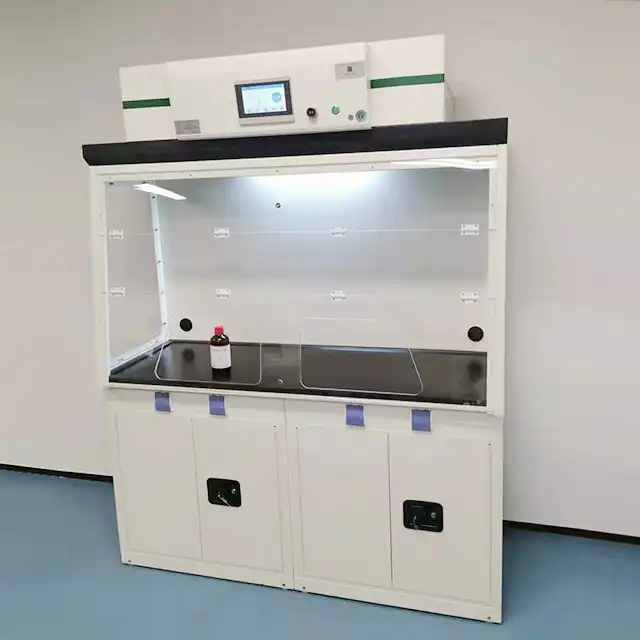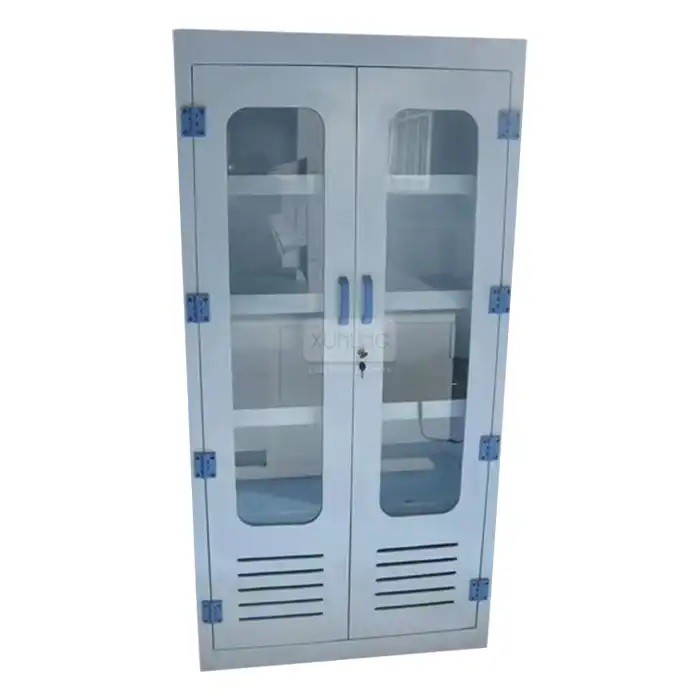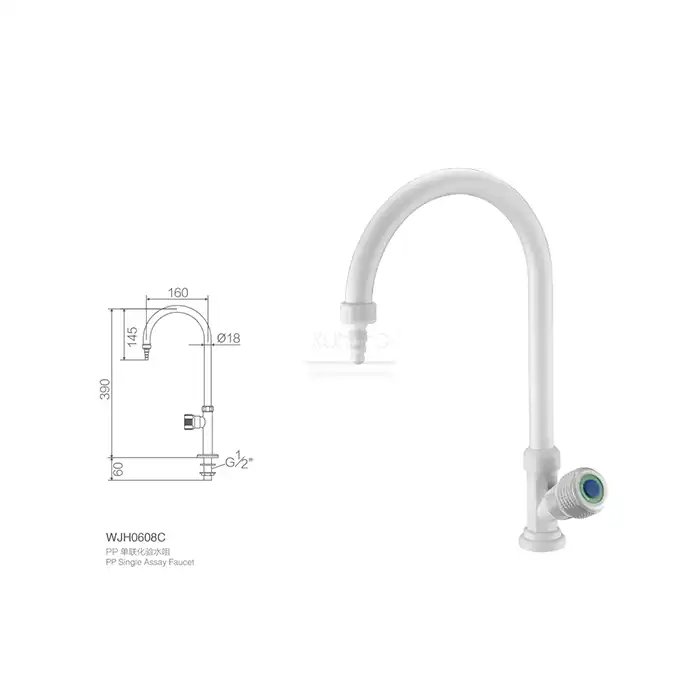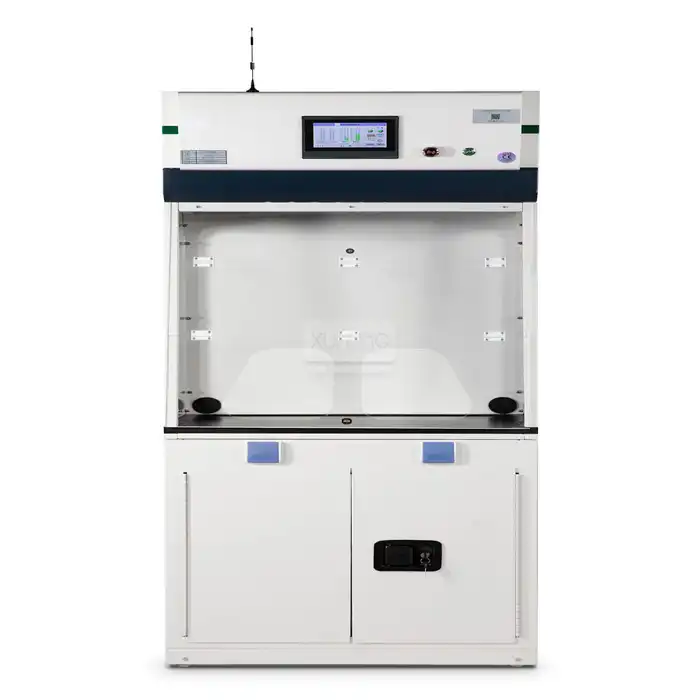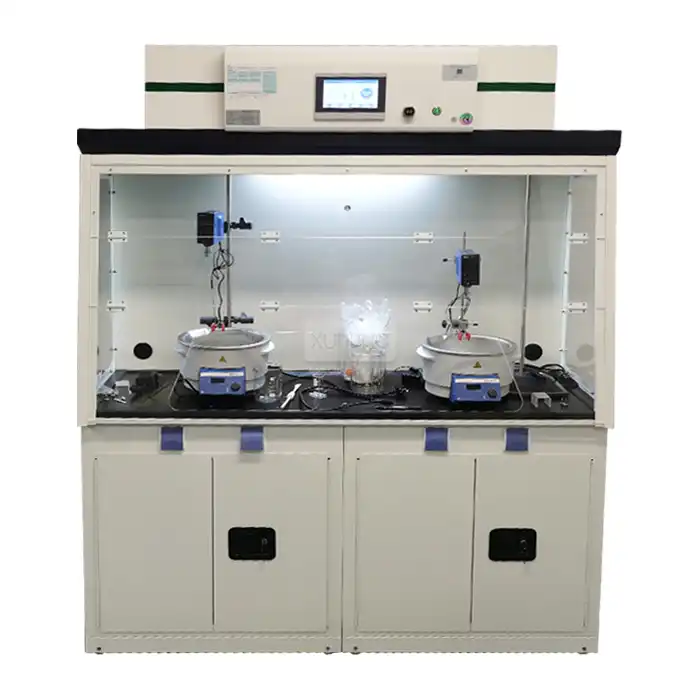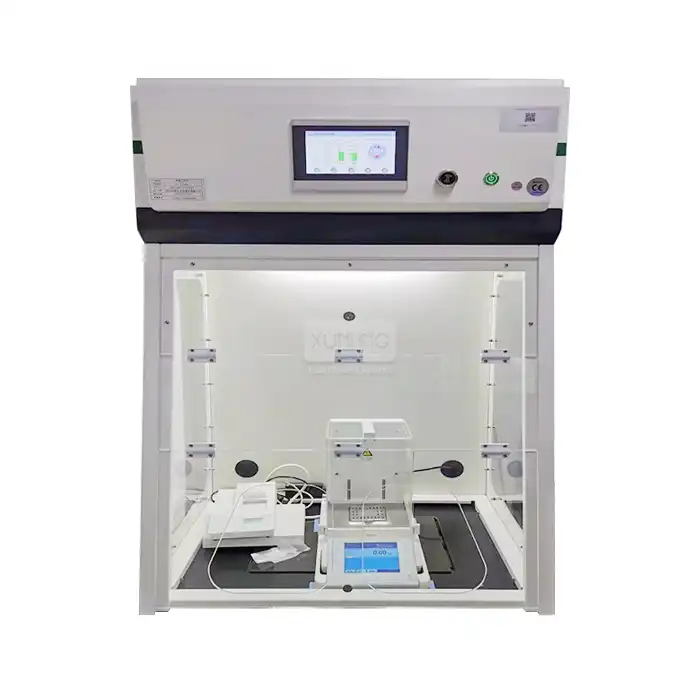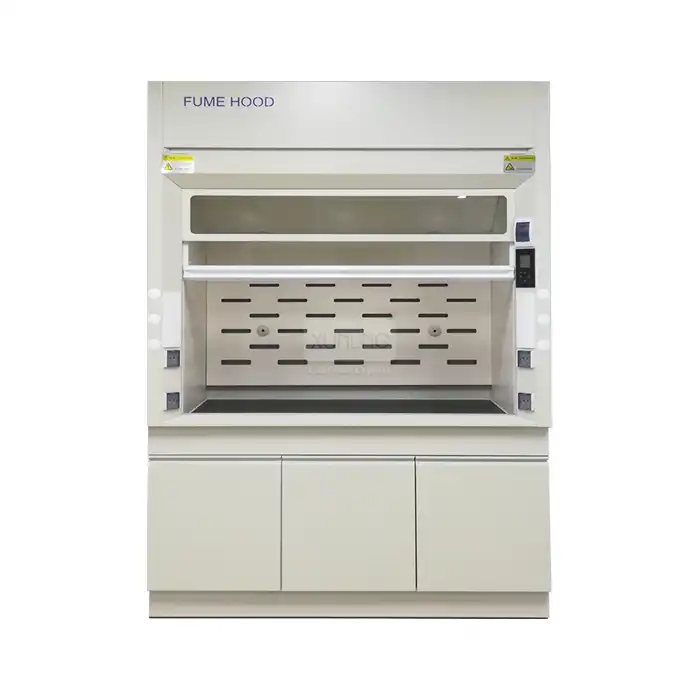
What maintenance is required for ducted fume cupboards?
2025-05-20 10:54:47
Laboratory safety is paramount in any research or industrial setting, and ducted fume cupboards play a critical role in maintaining a safe working environment. These specialized ventilation systems are designed to protect personnel by removing hazardous vapors, gases, and particles generated during experiments. However, like any sophisticated equipment, ducted fume cupboards require regular maintenance to ensure optimal performance and longevity. This blog post explores the essential maintenance requirements for ducted fume cupboards, providing laboratory managers and technicians with comprehensive guidance on keeping these vital safety systems in peak condition.

Proper maintenance of ducted fume cupboards involves several key components, including regular inspection of airflow performance, thorough cleaning of internal and external surfaces, and professional servicing of mechanical components. By implementing a structured maintenance schedule that addresses these areas, laboratories can ensure their ducted fume cupboard systems continue to provide reliable protection against harmful substances while complying with safety regulations. Neglecting maintenance not only compromises safety but can also lead to costly repairs and shortened equipment lifespan.
Regular Inspection and Performance Testing
Maintaining optimal performance of ducted fume cupboards requires systematic inspection and testing procedures. Regular assessment ensures these critical safety devices continue to function effectively, protecting laboratory personnel from harmful exposure.
Airflow Velocity Verification
Proper airflow velocity is the cornerstone of ducted fume cupboard functionality. Our professional-grade ducted fume cupboards are designed to maintain optimal airflow velocity between 0.3-0.6 m/s, ensuring efficient capture and removal of hazardous substances. Laboratory technicians should conduct monthly face velocity tests using calibrated anemometers to verify that airflow remains within this critical range. Documentation of these readings helps establish performance trends and identifies potential issues before they compromise safety. When airflow deviates from recommended parameters, it may indicate problems with the exhaust system, sash position, or internal baffles that require immediate attention. At Xi'an Xunling Electronic Technology Co., Ltd., we integrate sophisticated airflow monitoring systems into our ducted fume cupboards, providing continuous verification of proper functioning. Our superior airflow management technology creates consistent and reliable airflow patterns, efficiently capturing and removing hazardous airborne substances from the work area, which is vital for personnel safety and experimental integrity.

Sash Operation Assessment
The front sash of a ducted fume cupboard serves as both a protective barrier and an airflow regulator. Our ducted fume cupboards feature a standard front sash opening of 760 mm, designed for optimal operator protection and ergonomic access. Quarterly maintenance should include inspection of sash movement, ensuring smooth vertical or horizontal operation without binding or excessive effort. Technicians should check for proper counterbalance function, which prevents unexpected sash drops that could compromise containment or cause injury. Sash components require lubrication of pulleys, cables, and guide tracks according to manufacturer specifications. Additionally, inspect sash glass for cracks, chips, or distortion that might compromise visibility or structural integrity. Our robust construction using high-quality, corrosion-resistant materials ensures long-lasting performance of all components, including the sash system, even in harsh laboratory environments.
Exhaust System Evaluation
The exhaust system is the primary mechanism by which ducted fume cupboards remove hazardous substances from the laboratory environment. Our ducted fume cupboards feature a 250mm diameter exhaust vent that's compatible with standard ducting systems, ensuring seamless integration with your facility's ventilation infrastructure. Semi-annual maintenance should include inspection of exhaust fans, motors, and belts for signs of wear, unusual noise, or vibration. Technicians should verify proper duct connections, checking for leaks, obstructions, or corrosion that could impair system efficiency. Pressure differential across the ducted fume cupboard should be measured to ensure sufficient air movement through the system. Our advanced engineering reduces operational noise to ≤60 dB, creating a more comfortable and focused environment for your research team. Regular maintenance of the exhaust system helps maintain this low noise operation while ensuring the effective removal of hazardous substances from the laboratory space.
Cleaning and Contamination Control
Effective maintenance of ducted fume cupboards requires rigorous cleaning procedures to prevent contamination and ensure continued safety and efficiency.
Interior Surface Decontamination
The interior surfaces of ducted fume cupboards are directly exposed to chemicals and potentially hazardous substances, making regular decontamination essential. Our ducted fume cupboards feature high-quality corrosion-resistant galvanized steel construction, providing superior resistance to chemical damage while facilitating thorough cleaning. Monthly cleaning should involve removing all equipment and materials from the work surface, followed by targeted cleaning with appropriate solvents or detergents compatible with the specific contaminants and cupboard materials. Special attention should be given to work surfaces, sidewalls, and baffles where residue might accumulate. For particularly hazardous substances, specialized decontamination protocols may be necessary. After cleaning, surfaces should be thoroughly rinsed and dried to prevent chemical interactions with future experiments. This regular decontamination not only extends the life of your equipment but also prevents cross-contamination between different research projects.
External Component Maintenance
While internal surfaces face direct exposure to hazardous substances, external components of ducted fume cupboards also require regular maintenance. Quarterly cleaning of exterior surfaces, control panels, and sash handles helps prevent the accumulation of dust and contamination. Our ducted fume cupboards feature user-friendly controls and intuitive interfaces that make monitoring and adjusting airflow straightforward. Regular cleaning of these controls ensures their continued functionality and prevents the transfer of contaminants to other laboratory areas. The integrated LED lighting systems in our ducted fume cupboards provide excellent visibility of work areas but should be inspected and cleaned regularly to maintain optimal illumination. Light fixtures should be checked for proper operation, with bulb replacement performed as needed. External utility connections for gas, water, and electricity should also be inspected for leaks, corrosion, or damage during this maintenance.
Filter and Baffle System Cleaning
The internal airflow pattern in ducted fume cupboards is managed by a system of baffles that direct air movement for optimal containment and exhaust efficiency. Semi-annual maintenance should include inspection and cleaning of these baffles to remove accumulated particulates or residue that might restrict airflow. Our ducted fume cupboards incorporate superior airflow management systems, meticulously designed to create consistent and reliable airflow patterns that efficiently capture and remove hazardous airborne substances. Technicians should verify that baffles are correctly positioned according to manufacturer specifications and adjust as necessary. While ducted fume cupboards typically do not rely on filtration (unlike ductless models), any auxiliary filtration components should be inspected and replaced according to usage patterns and manufacturer recommendations. This systematic approach to baffle and filtration system maintenance ensures continued optimal performance of your ducted fume cupboard in all laboratory applications, from chemical research to pharmaceutical development.
Professional Technical Servicing
Beyond routine inspections and cleaning, ducted fume cupboards require periodic professional technical servicing to ensure continued safety and compliance.
Electrical System Verification
Ducted fume cupboards incorporate various electrical components that require professional inspection and maintenance. Our units operate on standard 220V, 50Hz power supply (customizable to meet regional requirements) and feature sophisticated electrical systems that control everything from lighting to airflow monitoring. Annual professional servicing should include comprehensive testing of all electrical connections, including power supply, control circuits, and safety interlocks. Technicians should verify proper grounding and inspect wiring for signs of wear, damage, or overheating. Fan motors require particular attention, with testing for proper current draw and operation. Our energy-efficient design helps reduce operating costs without compromising performance, making these systems both economical and environmentally responsible. Professional electricians should conduct insulation resistance tests and verify the functionality of any emergency shutdown features to ensure complete electrical safety.
Mechanical Component Inspection
The mechanical components of ducted fume cupboards, including fans, motors, and dampers, require annual professional inspection to ensure reliable operation. Our ducted fume cupboards feature robust construction that stands up to the rigors of daily laboratory work, but professional verification remains essential. Qualified technicians should disassemble components as necessary to inspect for wear, corrosion, or fatigue. Belt tension and alignment require verification, with adjustments or replacements performed according to manufacturer specifications. Bearings should be lubricated and checked for excessive play or unusual noise. Dampers and actuators need inspection for proper movement and sealing capability. This comprehensive mechanical servicing helps prevent unexpected failures that could compromise laboratory safety and interrupt critical research work. At Xi'an Xunling Electronic Technology Co., Ltd., we provide detailed maintenance guidelines and technical support to ensure your maintenance team can effectively service these critical mechanical systems.
Certification and Compliance Testing
Perhaps the most critical aspect of professional servicing is certification testing to verify that ducted fume cupboards continue to meet safety standards and performance specifications. Our ducted fume cupboards are manufactured in compliance with international standards, including ISO and CE, ensuring the highest quality and safest equipment available. Annual certification testing should be performed by qualified professionals using calibrated instruments to verify face velocity, containment efficiency, and overall performance. This testing typically includes ASHRAE 110 containment tests or equivalent procedures to verify the cupboard's ability to prevent the escape of hazardous substances. Documentation of these tests provides critical evidence of regulatory compliance and due diligence in maintaining laboratory safety. Professional certification not only ensures safety but also helps identify potential issues before they develop into serious problems, allowing for proactive maintenance that extends equipment life and prevents costly repairs. At Xi'an Xunling Electronic Technology Co., Ltd., we offer comprehensive support for certification testing, helping laboratories maintain compliance with all relevant safety standards.
Conclusion
Regular maintenance of ducted fume cupboards is essential for laboratory safety, equipment longevity, and regulatory compliance. By implementing comprehensive inspection routines, thorough cleaning protocols, and professional servicing schedules, laboratory managers can ensure these critical safety systems continue to provide reliable protection for personnel and research integrity. Proactive maintenance not only prevents costly breakdowns but also optimizes performance for more efficient laboratory operations.
Looking for high-quality ducted fume cupboards with exceptional performance and reliability? Xi'an Xunling Electronic Technology Co., Ltd. offers premium laboratory safety equipment designed for durability, efficiency, and ease of maintenance. With our 5-year warranty, custom-made solutions, and comprehensive after-sales support, we're your ideal partner for laboratory safety equipment. Contact our expert team today at xalabfurniture@163.com to discuss how our ducted fume cupboards can enhance safety and productivity in your laboratory environment.
References
1. American National Standards Institute. (2022). "Laboratory Ventilation Equipment: Performance Requirements for Ducted Fume Hoods." ANSI/AIHA Z9.5-2022.
2. Scientific Equipment and Furniture Association. (2023). "Recommended Practices for Laboratory Fume Hood Maintenance and Testing." SEFA 1-2023.
3. Johnson, R.L. & Williams, T.C. (2024). "Comprehensive Guide to Laboratory Safety Equipment Maintenance." Journal of Laboratory Safety Engineering, 42(3), 215-230.
4. European Committee for Standardization. (2023). "Laboratory Furniture and Fume Cupboards: Safety Requirements and Testing Methods." EN 14175-2023.
5. Zhang, H., & Peterson, K.L. (2022). "Long-term Performance Analysis of Ducted Fume Cupboards in Research Environments." International Journal of Laboratory Safety, 18(2), 87-102.
6. World Health Organization. (2023). "Laboratory Biosafety Manual: Ventilation Systems Maintenance Guidelines." WHO/CDS/CSR/LYO/2023.4.







